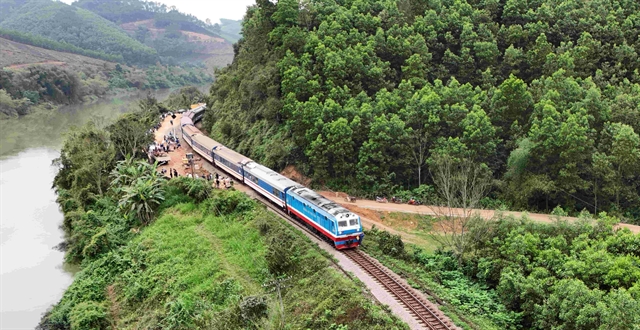 Economy
Economy

 |
| A part of the north-south railway. Việt Nam will develop a north-south high-speed railway project with a total investment of about US$67 billion. —VNA/VNS Photo |
HÀ NỘI — The north-south high-speed railway project is more than just a national infrastructure initiative — it's also a pivotal opportunity for Vietnamese enterprises to expand, innovate and thrive in the high-tech sector, a Việt Nam Railways Corporation representative said at a conference on the project and the participation of private firms held by the Dân Việt Newspaper on Wednesday.
Part of a national strategy to develop the nation's infrastructure and industrial capabilities, the north-south high-speed railway will stretch over 1,500km, connecting the northern and southern ends of Việt Nam.
With total investment exceeding VNĐ1.7 quadrillion (over US$67 billion), this ambitious infrastructure venture presents vast opportunities for domestic enterprises, paving the way for significant economic growth and industrial advancements.
Construction on the project is set to begin by December 31, 2026. The Government is eager to involve private enterprises in various stages, from supplying materials and building infrastructure to manufacturing equipment and operating the system once completed.
Tạ Mạnh Thắng, deputy head of the International Cooperation and Science-Technology Department at Việt Nam Railways Corporation, explained that this is not just a high-speed railway project, but also a development strategy for the entire national railway industry, with a long-term vision and huge financial scale.
Thắng noted that infrastructure projects like the Hà Nội – Hải Phòng – Lào Cai electrified railway lines or north-south high-speed routes could result in significant economic spillover effects.
In addition, labour demand for the railway project is expected to be immense. With a projected need for about 20,000 employees during the operation phase and up to 80,000 workers during construction, the project will create thousands of jobs and have a positive impact on the labour market and social security.
Resolution 68 and changes in laws, including the Enterprise Law and the High Technology Law, present favourable conditions for private Vietnamese businesses to enter the railway sector.
Private enterprises will be integral in manufacturing components, providing construction materials and supplying technology for various aspects of the railway project.
Notably, Vietnamese firms like Hòa Phát, a producer of high-strength steel, and Thaco, a major vehicle manufacturer, have already begun preparations to engage in the project by learning about international practices and adapting their technologies.
Chairman of the Việt Nam Association of Construction Contractors Nguyễn Quốc Hiệp emphasised that construction companies could undertake more than half of the infrastructure development, which would generate significant employment opportunities.
Despite these promising opportunities, private enterprises face several hurdles, particularly in accessing advanced technology.
High-tech items crucial to the success of the railway project remain a barrier, which necessitates the active role of the State in facilitating technology transfer and supporting the training of workers in sectors like engineering, procurement and construction, as well as public-private partnerships.
He also pointed out the sector’s acute shortage of skilled labour, particularly engineers, which poses a challenge for large-scale projects like the high-speed railway.
With a significant portion of the workforce currently unskilled, the construction sector will struggle to meet project demands.
Businesses have called on the Government to implement policies to attract and train more skilled workers, potentially even importing labour if necessary, to ensure the successful completion of the project.
To enable domestic enterprises to fully participate in the railway sector, business leaders have urged the Government to offer further incentives.
Technical Director at FECON Joint Stock Company Hồ Đức An suggested that the Government could provide tax breaks, land support and favourable credit conditions to businesses involved in the production of materials and construction.
He also proposed tax exemptions for importing key railway components and equipment that are not yet locally produced but essential for the project.
Government funding in research, technology transfer and workforce development will also be crucial for businesses to succeed in the competitive high-tech railway industry.
By creating an ecosystem that supports these industries, the Government can stimulate long-term growth and position Việt Nam as a leader in railway infrastructure development in the region. — VNS




